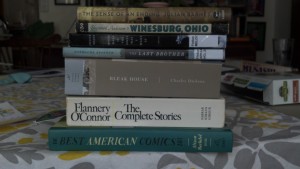Guppy turned 6 this week! I showed him the cake section of Joanne Chang’s Flour, which I received for Christmas but had not yet worked up the gumption to cook from. Guppy, who knows his own mind, passed by the chocolate cake with chocolate frosting, the chocolate cupcakes with magic frosting, and said he wanted the lemon-raspberry cake. The recipe is in small type over three pages. I asked, “Are you sure?” and showed him the picture of the cupcakes again. He was sure.
The day before Guppy’s birthday, I made a trip to our grocery co-op, since I did not have on hand the requisite: cake flour, nearly 2 pounds of butter, 14 eggs (for 14 whites but only 12 egg yolks), bag of lemons, nearly 5 cups of sugar, and 2 boxes of very lovely, organic, USA, on-sale raspberries.
Day one. On Guppy’s birthday, his older brother Drake vomited for the second morning in a row. Dealing with that left me less than energized to start a major baking project, but I rallied in the late morning and made the three cake layers and the homemade lemon curd. The cakes involved whipping egg whites then folding them into a very thick batter. The lemon curd used up my bag of lemons and I needed more to make the lemon syrup, so I asked Guppy if I could finish his cake the next day if we got dessert out that night. He graciously agreed, and I was able to procure more lemons.
Day two. The recipe says to make the buttercream frosting before the lemon syrup, but since I read the recipe beforehand, and the syrup needs to cool to room temp, I did it in reverse order.
Here is lemon syrup cooling in back and sugar syrup in front. Buttercream frosting involves making a sugar syrup heated to a certain temperature, then taking the warm syrup and adding it very slowly to an egg mixture, and then adding a $hit-ton of butter and whipping for a long time. Note candy thermometer, one of those kitchen tools that denotes this recipe as hard core, IMO. It’s a kitchen gadget I use about once a year, if that, but I always feel competent that I have it when it’s called for. Also, my neighbors know that I have one, so they borrow mine when needed.

This is the egg/syrup mixture, before I added butter and whipped it to a total end volume of about six cups. I nearly forgot to put in a pound of butter, as putting in half a pound made me think I was finished. Silly me.

To assemble the cake, each layer needed to be brushed with about 1/3 cup of the lemon syrup, then topped with a cup of buttercream, to which a flood barrier of frosting was adding around the edge to prevent the subsequent raspberries and lemon curd from oozing out. Which they did anyway in a few spots, so I should have been more aggressive in my frosting flood barriers.

So then, lemon curd inside barrier, topped with raspberries, next layer, soaked with syrup, frosting, flood barrier, lemon curd, raspberries, and that got me here:

I topped that with the third layer, brushed it with lemon syrup, then the whole thing needed to refrigerate for at least an hour to firm up. I took a nap.
Now firm, the cake needed a crumb coat–a thin layer of all-over frosting to make sure the crumbs stay under the outer layer of frosting. This took another cup of frosting, then had to refrigerate for 30 minutes, during which I washed some of the eight zillion dishes and tried to wipe up some of the butter, which seemed to coat every kitchen surface now.

Next up was the all-over frosting, about a cup and a half, and then the remaining lemon curd, spread on the top. By this time, the boys were home from school, and big brother Drake said he wanted to put the raspberries on top of the cake. I asked that he test his design on the bottom of a cake pan before transferring it.

He wanted a ring around the cake, and I suggested using the few remaining berries to make a 6, which conveniently also looked like a “G.”

Here is what it looked like once we cut into it

And on the plate

Throughout the two days of making this cake, I was fearful that it would not be good, that it would be too sugary, soggy from the syrup, etc. I knew as I was doing it that it was way too much work unless the end result was going to be delicious. But it was. So: giant pain in the butt, yes. Worth it for a special someone on a special occasion, like my very happy six-year-old boy? You bet.
If you were reading to the end of this hoping for the recipe, sorry. It’s three pages of tiny type. No way am I transcribing it. I spent 2 days on the cake (and probably more hours making it than I did laboring to have Guppy himself), and all morning uploading the photos for this entry.
Daily Delicious has the recipe with European amounts here. But I suggest you borrow the book from the library, or just buy it. I think it’s worth it for the photos alone, but it’s full of other recipes I want to try too, like home-made Oreos









